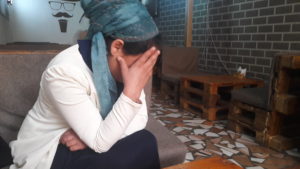
Author: Nargis Hamrabaeva, Tajikistan
In her memories, her life is divided into ‘before’ and ‘after’ she learned she had HIV. As strange as it may seem, with the therapy ‘after’ is not a verdict, not a tragedy, not the end…
We are meeting 29-year-old Amina (the name has been changed) in one of the coffee houses in Dushanbe, Tajikistan. She came to our meeting after work, short of breath, as she was afraid to be late. Good looking, with a glow of health on her cheeks, a strand of hair appearing from under her neatly tied headscarf, and snow-white teeth. One could say that she was to the full of her health.
Sipping her coffee, she tells her story. Amina has been living with HIV for nine years and she is not at all ashamed of her status. She is convinced that a person with such diagnosis may live the same life as with any other chronic disease. The main thing is to take antiretroviral (ART) therapy on time and attend medical check-ups.
Fire, hospital, blood transfusions…
In 2007, Amina married her distant family member. In fact, as it often happens in Tajik families, her parents arranged their marriage.
“It happened that my two sisters married the relatives of my father and to keep some kind of “balance,” my marriage was arranged with my mother’s family relative. I struggled. We lived in the house of my husband’s parents. My sisters-in-law, who moved back to their parents’ house after the divorce, also lived with us. I could only dream of a quiet life,” tells Amina.
Sometimes, the young woman became an object of her sisters-in-law’s vengeance after their quarrels with her husband. Once, after another big quarrel, Amina made a bonfire in the yard and was cooking some food in a big pot. She already had a one-year-old and was pregnant with her second baby. The girl was throwing more brushwood into the fire to make it stronger when suddenly someone approached her from behind and pushed her right into the flame…
Amina woke up in a hospital ward several days after. She was in awful pain – she had 40% of her skin burnt. Ahead, she had two months of hospital stay, treatment, loss of her baby, interrogations of police officers and many blood transfusions. It turned out that it was one of her sisters-in-law who pushed her into the fire.
After several months, the wounds of her body and soul were healed and Amina got pregnant again. As all pregnant women, she did all the required tests, including an HIV test. It came back positive. She was worried, desperate, scared. She did not know what to do. Professional psychologists of the AIDS center talked to her and explained that it was not the end, that she would need to take her therapy and would be able to live a normal life with certain conditions.
“You have HIV and you will die in half a year”
However, the conversation with her husband was hard.
“He also got tested and his result was negative. He blamed it all on me; said that if I have HIV, I would die in half a year. He said that he wanted neither me nor our child. Soon I gave birth to our second son, but it did not save our marriage. We broke up. Both my boys are HIV-negative,” adds Amina.
She thinks that she got infected during one of the blood transfusions in the hospital.
“After the diagnosis, you can and should go on living your life,” the woman is saying now. Earlier, she was alone and hopeless. Her children were her only comfort. For them, she was fighting for her life. “I have been taking ART for five years. It includes several drugs, each of which influences a certain stage in the HIV replication cycle. In other words, when a person takes the therapy, the virus no longer replicates in the cells of his immune system.”
Building a house and finding a true love
A local organisation working with HIV-positive women helped Amina to become stronger and believe in herself. Now the young woman works as an outreach worker there, helping other women who are diagnosed with HIV to overcome their fears and depression. Her two wonderful boys are growing up. One of them goes to the third grade, and the second one has started his first year in school.
“To my ex-husband’s surprise, I am still alive, though nine years have already passed,” she says with a smile on her face. “Money that I make here is enough for us, but I am afraid to think about what can happen if the project is closed. Now there is a crisis everywhere. I could go to Russia to earn some money, but there I would have to make a mandatory HIV test to get a job and then I might face deportation.”
“What is your dream?”, I am asking her.
“Now I am on a waiting list to get a land plot and I would like to build a house for my children,” says Amina. Currently, she lives with her mother and her brother’s family. “They are all well aware of HIV, they know the routes of transmission, so they are not afraid to give me a hug or to eat from one bowl with me, and my brother’s wife sometimes leaves her children for me to look after.”
Besides, Amina is dreaming about meeting her true love and creating a family. This strong and self-confident young woman may be a role model for many people living with HIV.



